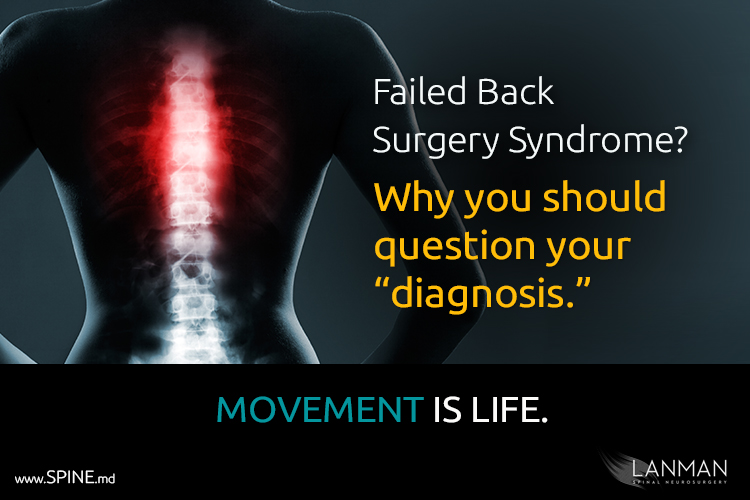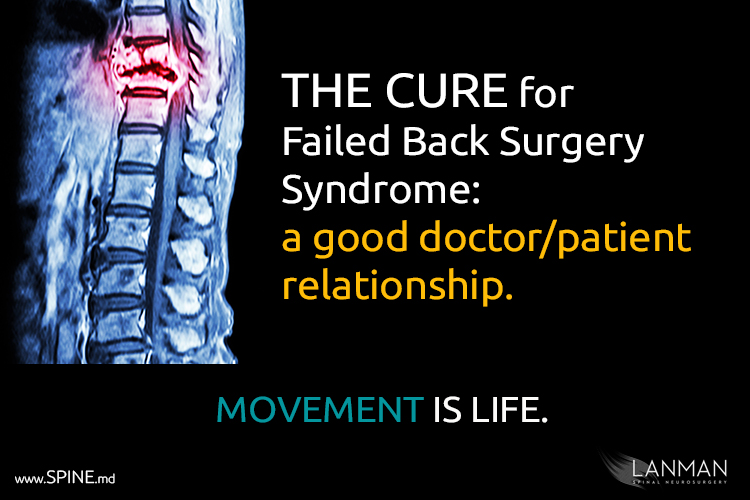Failed Back Surgery Syndrome – otherwise known as FBSS – is not a real diagnosis. While I’ve met patients that have been given this “diagnosis” by other physicians and appreciate their genuine pain, the cause of the condition is too broadly defined.
When I went to medical school, one of the first things I learned was that every word has meaning. The word “diagnosis” connotes a process whereby a physician identifies and describes the distinctive nature of an illness or other problem through examination and evaluation of symptoms. FBSS, as a diagnosis at least, fails that definition.
I found several websites that promote catalogs of possible “factors” that can lead to the condition. From Wikipedia there is the most concise list that I saw includes recurrent spinal disc herniation, post-operative pressure on a spinal nerve, joint instability, scar tissue (or fibrosis), depression, anxiety, sleeplessness, spinal muscular deconditioning and even Propionibacterium acnes – a bacterial infection.
What I see, as a physician of 25 years of experience, is a list of distinct and separate diagnosis. For instance, the first three on that list; recurrent spinal disc herniation, post-operative pressure on a spinal nerve, and joint instability; are post-operative conditions that can occur after the four major back surgeries that a patient can have: laminectomy, discectomy, spinal fusion, and artificial disc replacement.
It is possible that a patient may have additional post-operative herniations or that a physician may have misjudged the condition of adjacent discs and only operated on the more immediate and obvious herniation. It is not uncommon for a physician to relieve nerve pressure in one area, using a procedure called laminectomy, and not detect additional sources of nerve compression. It’s also possible that spinal fusion or artificial disc replacement can lead to joint issues that can lead to further back or neck pain.
Unfortunately, for many cases of FBSS that I have seen, the cause is not a syndrome at all, but a problem with the ongoing and persistent pressure for doctors to spend as little time as possible with their patients. At my practice in Beverly Hills, CA and my work as an affiliated surgeon at Cedar Sinai Medical Center in Los Angeles, CA, a post-operative diagnosis like FBSS, to me, sounds like a non-distinct way to say, “Sorry, we missed something.”
The spine is one of the most complex parts of the skeletal system: 33 interlocking bones (vertebrae) that articulate, twist, and bend while protecting one of the most vulnerable components of the brain – the spinal cord – and distributing a complex web of nerves to all parts of the body. And some surgeons spend as little as 5 minutes discussing diagnosis and treatment plan with their patients. To use a social media acronym – #SMH.
I will often spend an hour or more with any new patient – and that’s before I prescribe x-rays or a scan. On the first meeting, we’ll talk about the patient’s work, cellphone habits, hobbies, physical activities, past experiences, accidents – anything at all that can give me a clue about how this patient wound up sitting in front of me with sometimes excruciating neck and back pain.
Many physicians rely on what they find from the MRI or the X-ray film. Faced with insurance rules or their own rules, some surgeons will try to streamline the process as much as possible. With 33 bones and innumerable strands of nerves, a physician that’s in too much of a hurry will overlook even the most obvious signs.
This digs at the very nature of what is now popularly called a “syndrome.” While most cases may lack pathogenesis, the cause is pervasive and difficult to root out.
I heard a statistic that more than 85% of all patients in the U.S. now use the web to investigate their diagnosis and treatment. I’m one physician who applauds this trend, and I hope it only grows stronger. It is vitally important to remember that a diagnosis is not a diagnosis until it is specific.







